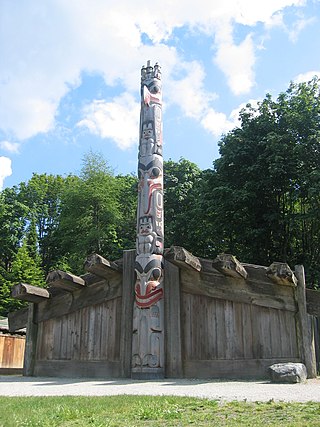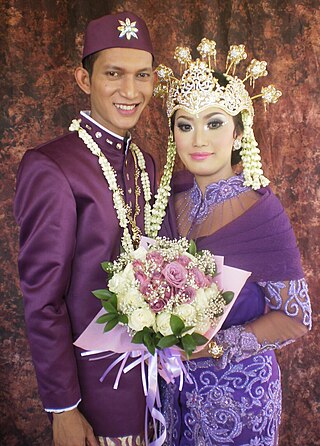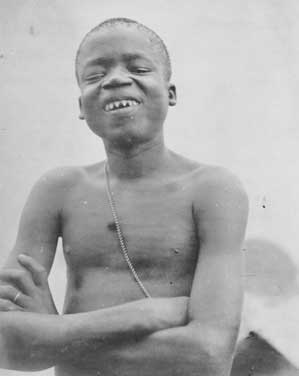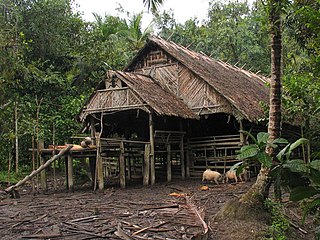Related Research Articles

West Sumatra is a province of Indonesia. It is located on the west coast of the island of Sumatra and includes the Mentawai Islands off that coast. The province has an area of 42,119.54 km2 (16,262.45 sq mi), with a population of 5,534,472 at the 2020 census. The official estimate at mid 2022 was 5,640,629. West Sumatra borders the Indian Ocean to the west, as well as the provinces of North Sumatra to the north, Riau to the northeast, Jambi to the southeast, and Bengkulu to the south. The province is subdivided into twelve regencies and seven cities. It has relatively more cities than other provinces outside of Java, although several of them are relatively low in population compared with cities elsewhere in Indonesia. Padang is the province's capital and largest city.

A longhouse or long house is a type of long, proportionately narrow, single-room building for communal dwelling. It has been built in various parts of the world including Asia, Europe, and North America.

The culture of Indonesia has been shaped by long interaction between original indigenous customs and multiple foreign influences. Indonesia is centrally-located along ancient trading routes between the Far East, South Asia and the Middle East, resulting in many cultural practices being strongly influenced by a multitude of religions, including Buddhism, Christianity, Confucianism, Hinduism, and Islam, all strong in the major trading cities. The result is a complex cultural mixture, often different from the original indigenous cultures.

The Sunda or Sundanese are an indigenous ethnic group native to the western region of Java island in Indonesia, primarily West Java. They number approximately 42 million and form Indonesia's second most populous ethnic group. They speak the Sundanese language, which is part of the Austronesian languages.

Siberut is the largest and northernmost of the Mentawai Islands, located 150 kilometres west of Sumatra in the Indian Ocean. It covers an area of 3,838.25 km2 including smaller offshore islands, and had a population of 35,091 at the 2010 Census and 40,220 at the 2020 Census. A part of Indonesia, the island is the most important home for the Mentawai people. The western half of the island was set aside as the Siberut National Park in 1993. Much of the island is covered with rainforest, but is subject to commercial logging.

The pig-tailed langur, monotypic in genus Simias, is a large Old World monkey, endemic to several small islands off the coast of Sumatra in Indonesia. Its face is black, its fur is black-brown and it has a relatively short tail. It is a diurnal species, feeding in the rainforest canopy on leaves, and to a lesser extent, fruit and berries. Little is known of its natural history, but it is heavily hunted, its populations have been declining rapidly and the International Union for Conservation of Nature has assessed its conservation status as being "critically endangered". It has been included on a list of the World's 25 Most Endangered Primates.

In Malaysian, Bruneian and Indonesian folklore, Bunian people or Orang bunian are supernatural beings said to be invisible to most humans, except those with "spiritual sight". While the term is often translated as "elves", it literally translates to "hidden people" or "whistling people". Orang bunian are described as beautiful, dressed in ancient Southeast Asian style, and nearly identical to humans in appearance. Some mythological accounts describe the lack of a philtrum. Modern depictions of Orang bunian deviate from the traditional folklore by including elf-like features, pointed ears, high fantasy-influenced attire, or modern Minangkabau long coat clothing.

Mentawai people are the native people of the Mentawai Islands about 100 miles from West Sumatra province, Indonesia. They live a semi-nomadic hunter-gatherer lifestyle in the coastal and rainforest environments of the islands and are also one of the oldest tribes in Indonesia. The Mentawai population is estimated to be about 64,000. The Mentawai tribe is documented to have migrated from Nias – a northern island – to the Mentawai islands, living in an isolated life for centuries until they encountered the Dutch in 1621. The ancestors of the indigenous Mentawai people are believed to have first migrated to the region somewhere between 2000 and 500 BCE. The Mentawai language belongs to the Austronesian language family. They follow their own animist belief system called Arat Sabulungan, that links the supernatural powers of ancestral spirits to the ecology of the rainforest. When the spirits are not treated well or forgotten, they might bring bad luck like illnesses and haunt those who forgot them. Mentawai also have very strong belief towards objects they think are holy. The people are characterized by their heavy spirituality, body art and their tendency to sharpen their teeth, a cultural practice tied to Mentawai beauty ideals. Mentawai tend to live in unison and peace with the nature around them because they believe that all things in nature have a form of spiritual essence.

The architecture of Indonesia reflects the diversity of cultural, historical and geographic influences that have shaped Indonesia as a whole. Invaders, colonizers, missionaries, merchants and traders brought cultural changes that had a profound effect on building styles and techniques.

Human tooth sharpening is the practice of manually sharpening the teeth, usually the front incisors. Filed teeth are customary in various cultures. Many remojadas figurines found in part of Mexico have filed teeth and it is believed to have been common practice in their culture. The Zappo Zap people of the Democratic Republic of Congo are believed to have filed their teeth.

The Sakuddei or Sabiroet people are an ethnic group, one of at least eleven, on the island of Siberut, Indonesia. Siberut is the northernmost of the Mentawai Islands which are located 130 km (81 mi) to the west off the coast of Sumatra. The Sakuddei live in south-central Siberut in an egalitarian society, cut off from the outside world. They speak a dialect of the Malayo-Polynesian Mentawai language.

Rumoh Aceh is a type of traditional vernacular house found in the Aceh Province in Indonesia. It is basically a wooden pile dwelling. Rumoh Aceh is also known as krong bade, which may actually refer to the rice granary and not the house. Rumoh Aceh is the largest and tallest of all vernacular house type found in the Aceh Province, the others are the Rumoh Santeut and the Rangkang.

Uma are traditional vernacular houses found on the western part of the island of Siberut in Indonesia. The island is part of the Mentawai islands off the west coast of Sumatra.

Rumah adat are traditional houses built in any of the vernacular architecture styles of Indonesia, collectively belonging to the Austronesian architecture. The traditional houses and settlements of the several hundreds ethnic groups of Indonesia are extremely varied and all have their own specific history. It is the Indonesian variants of the whole Austronesian architecture found all over places where Austronesian people inhabited from the Pacific to Madagascar each having their own history, culture and style.

The Enggano people are an isolated, but contacted, tribe which inhabits Enggano Island. Enggano Island is a small island located adjacent to the southwest coast of Sumatra in Indonesia. The population of Enggano people is not closely tracked. As such, no population estimates beyond the year 2000 appear to exist. Furthermore, the estimates from 1990 and 2000 are not in agreement. The source for the year 2000 estimates that there were 1,500 Enggano people inhabiting the island, while the 1999 source estimates that there were approximately 1,000 Enggano people inhabiting the island. However, both sources agree that the population is likely to continue decreasing.

Palembang, Palembangs, or Palembangese are one of the indigenous Sumatrans native to the southeastern Sumatra regions of Palembang in Indonesia. There are approximately 3,800,000 native Palembang living in regions across Indonesia, and there are about 30,000 Palembang diaspora living outside of Indonesia, mainly in Singapore.

Rangkiang is a granary or rice barn of the Minangkabau people used to keep rice. The rangkiang is a distinctive feature of Minangkabau architecture. The structure is traditionally found in the courtyard of a rumah gadang, the traditional house of Minangkabau people.

Rumah limas, also known as rumah bari, is a type of traditional house found in Palembang, South Sumatra, Indonesia. They can also be found in Baturaja. The house is traditionally built of wood and raised on stilts, with a stepped, or gradated, floor composed of two to five areas at slightly different heights, with a broad porch, and a distinctive roof. In Palembang, these houses are associated with the nobility and other people of high status.

Rumah ulu is a vernacular house found in the highland of South Sumatra, Indonesia. The house is associated with the Uluan people who reside in the region of the upstream of the Ogan and Musi River.

Mosque architecture in Indonesia refers to the architectural traditions of mosques built in the archipelago of Indonesia. Initial forms of the mosque, for example, were predominantly built in the vernacular Indonesian architectural style mixed with Hindu, Buddhist or Chinese architectural elements, and notably didn't equip orthodox form of Islamic architectural elements such as dome and minaret. Vernacular architectural style varies depending on the island and region.
References
- 1 2 Schefold, Reimar (1966). Versuch einer Stilanalyse der Aufhängehaken vom Mittleren Sepik in Neu-Guinea: Auch erschienen als Bd. Basler Beiträge zur Ethnologie (in Dutch). Vol. 4. Pharos-Verlag. p. 304.
- ↑ "The 3rd EuroSEAS Conference". School of Oriental & African Studies, University of Londo. 6–8 September 2001. Archived from the original on 16 June 2010. Retrieved 30 October 2010.
- 1 2 Schefold, R. (2001). "Three sources of ritual blessings in traditional Indonesian societies". Bijdragen tot de Taal-, Land- en Volkenkunde. Leiden. 157 (2): 359–381. doi: 10.1163/22134379-90003812 .
- ↑ Schefold, R. (1982). The culinary code in the Puliaijat ritual of the Mentawaians. Igitur.
- ↑ Wagner, Wilfried (1999). Mentawai: Identität im Wandel auf indonesischen Ausseninseln. Übersee-Museum. ISBN 3-88299-059-7.
- ↑ Schefold, R. (1973). "Religious Conceptions on Siberut, Mentawai". Sumatra Research Bulletin (Berita Kajian Sumatera), II, 2, pp. 1224.
- ↑ Schefold, R. (1981), The traditional culture of Siberut
- ↑ Schefold, R. (1999), Nature in songs, songs in nature : texts from Siberut, West Sumatra, Indonesia
- ↑ Schefold, R. (2007), "Ambivalent Blessings. Head-Hunting on Siberut (Mentawai) in a Comparative Southeast Asian Perspective", Anthropos, 102, 2, pp. 455-478
- ↑ Schefold, R., Nagel, U., Hauser-Schäublin, B., Schulstelle Dritte Welt (Bern), Schweizerische Gemeinschaft für den Lehr- und Forschungsfilm., & WWF Schweiz. (1982). Sei gut zu deiner Seele: Leben im tropischen Regenwald : das Beispiel der Sakuddei ("Be nice to your soul: life in the tropical rain forest: the example of Sakuddei"). Unterrichtshilfe des WWF-Lehrerservice und der Schulstelle Dritte Welt. Zürich: WWF-Lehrerservice. (in German).
- ↑ McNeely, Jeffrey A.; Sochaczewski, Paul Spencer (1995). Soul of the tiger: searching for nature's answers in Southeast Asia. University of Hawaii Press. p. 161. ISBN 0-8248-1669-2.
- ↑ "Asia". greenhomebuilding.com. Retrieved 30 October 2010.
- ↑ Shahshahani, Soheila (2004). Body as medium of meaning. LIT Verlag Münster. p. 34. ISBN 3-8258-7154-1.
- ↑ Schefold, Reimar; P. Nas; Gaudenz Domenig (2004). Indonesian Houses: Tradition and transformation in vernacular architecture, Volume 1. NUS Press. pp. 9, 47–50. ISBN 9971-69-292-9.
- ↑ "Framing Indonesian Realities: Essays in Symbolic Anthropology in Honour of Reimar Schefold". paperbackswap.com. Canadian Museum of Civilization/Musee Canadie. May 2004. Retrieved 30 October 2010.
- ↑ Schefold, R. (April 2002). "Stylistic canon, imitation and faking: Authenticity in Mentawai art in Western Indonesia". Anthropology Today. 18 (2): 10–14. doi:10.1111/1467-8322.00109.